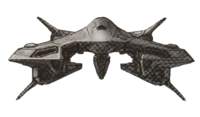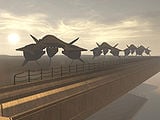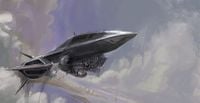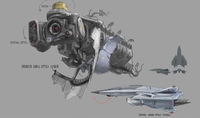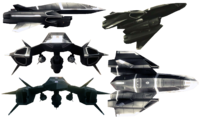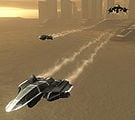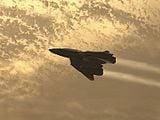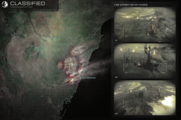F-99 Wombat: Difference between revisions
From Halopedia, the Halo wiki
m (Text replacement - "{{[Ee]ra\|[^}\n]*(Forerunner|Covenant|Human|UNSC|HCW|Post)[^}\n]*}}" to "{{Status|Canon}}") |
Coalition9 (talk | contribs) (→Trivia) |
||
| Line 29: | Line 29: | ||
==Trivia== | ==Trivia== | ||
{{linkbox|gallery=yes}} | {{linkbox|gallery=yes}} | ||
Unlike the majority of UNSC air vehicles (which bear the names of birds or other flying animals), the Wombat bears the name of an [[Wikipedia:Wombat|arboreal marsupial]] native to Australia. | *Unlike the majority of UNSC air vehicles (which bear the names of birds or other flying animals), the Wombat bears the name of an [[Wikipedia:Wombat|arboreal marsupial]] native to Australia. | ||
*There appers to be a cut version of the Wombat in the Halo Reach files. | |||
==Gallery== | ==Gallery== | ||
Revision as of 13:16, August 1, 2022
| F-99 Wombat | |
|---|---|

| |
| Production information | |
|
Role: |
Aerial reconnaissance |
| Technical specifications | |
|
Crew: |
Unmanned |
| Chronological and affiliation | |
|
Era: |
|
|
Affiliation: |
|
The F-99 Wombat, colloquially known as the "drone fighter", is an unmanned combat aerial vehicle (UCAV) used by the United Nations Space Command.[1]
Overview
Usage
During the Battle of Mombasa in October 2552, numerous F-99 UCAVs were deployed in reconnaissance elements numbering two to three aircraft to the city of New Mombasa, presumably from aircraft carriers a few kilometers off the coast.[2] They provided air support for embattled Marines across the city, particularly the Uplift Nature Reserve. The collective optical feeds provided by drones could also be accessed by ground forces through the UNSC battle network.[3] One of these drones crashed into a statue in front of the Reserve and its ejected optics package was later found by a lone ODST.[4][5] The Surakan Militia Volunteers had an unknown number of Wombats. In 2558, during the Carrow Conflict, the SMV used an F-99 to spy on the Jiralhanae position, it managed to transmit several images before being shot down.[6]
The AKIS helmet was developed to employ a wide array of targeting features to maximise range-finding capabilities for airborne craft such as the Wombat or S-14 Baselard.[7]
Production notes
The F-99 Wombat was originally going to be featured in Halo 3.[8] Though they were omitted from the final game, they were redesigned and featured in Halo 3: ODST. Drones of a different model, which are based directly on the concept art, appear in the background of the multiplayer map Longshore. However, given the depiction of the craft in Longshore as distant background details, it is possible that these are simply meant to be low-detail renderings of the F-99.
Trivia

|
Browse more images in this article's gallery page. |
- Unlike the majority of UNSC air vehicles (which bear the names of birds or other flying animals), the Wombat bears the name of an arboreal marsupial native to Australia.
- There appers to be a cut version of the Wombat in the Halo Reach files.
Gallery
Concept art of the Wombat The Art of Halo 3.
- H3ODST Wombat Variant1 Concept.jpg
Concept art of the drone.
- H3ODST Wombat Variant2 Concept 1.jpg
Concept art of a different look to the drone.
- H3ODST Wombat Variant2 Concept 2.jpg
Concept art of the underside of the drone.
- H3ODST Wombat Variant2 Concept 3.jpg
Concept art of the front view of the drone.
- H3ODST Wombat Variant2 Concept 4.jpg
Concept art of the top view of the drone.
List of appearances
- Halo 3 (First appearance)
- Halo 3: ODST
- Halo: Reach (Indirect mention)
- Halo: Hunters in the Dark
- Halo: Envoy (Mentioned only)
Sources
- ^ Halo 4: The Essential Visual Guide, page 72
- ^ Halo 3, multiplayer map Longshore
- ^ Halo 3: ODST, campaign level Tayari Plaza
- ^ Halo 3: ODST, campaign level Mombasa Streets
- ^ Halo 3: ODST, campaign level Uplift Reserve
- ^ Halo: Envoy, Chapter 11 page 155
- ^ Halo Waypoint, Canon Fodder - Pen Umbra (Retrieved on Apr 25, 2021) [archive]
- ^ The Art of Halo 3, page 39
